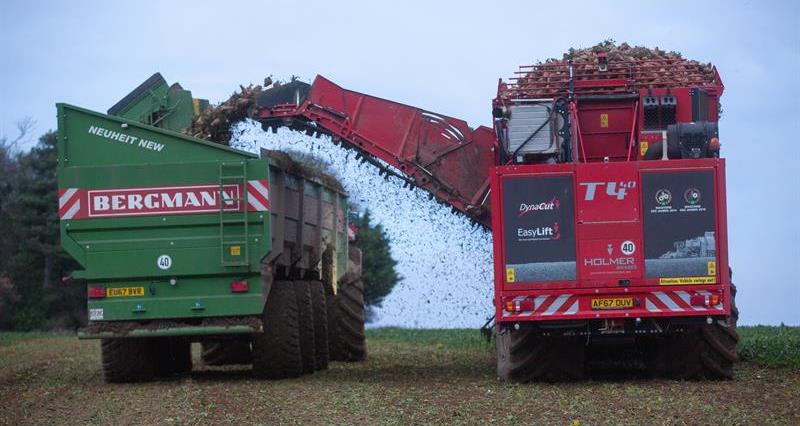Here we have broken down the sample and tarehouse procedure into 15 steps to help you understand what happens to your sugar beet once it crosses the weighbridge.
if you do have any further questions, please call our Beet Intake Manager Greg Brighouse on 01366 377 481.
| Step 1 | Sample buckets unloaded onto the conveyor. Samples are taken off the cages in chronological order starting with the first sample to keep within the 24 hour time limit |
| Step 2 | Samples on their way upwards to the “Dirty Scale” where they will be weighed as a whole including the dirt, clods and stones etc. |
| Step 3 | Scale is checked every hour to ensure it is weighing correctly |
| Step 4 | Sample bucket emptied into tray Stub card removed from pot Stub card swiped and sample weighed. Stub card Placed back in blue pot and lid sealed When a washer is available then the sample is tipped into washer with blue pot to identify the sample at the clean scale. |
| Step 5 | Washer rotates clockwise Beet and blue pot with stub card proceeds to clean station Washer checks on – Speed of rotation, 11bar pressure of water, jet nozzle size Check on water temperature is below 20°C– Reduction in sugar the higher the temperature. Slat gap width is checked every year and must not exceed 7.0mm otherwise the barrel needs to be replaced. |
| Step 6 | All that has not been washed away from the dirty sample is dispensed into the sample trolley at washer exit this includes any clods, stones or other non-beet larger than the gaps. This area is known as the clean station Button pushed to alert dirty scale operator that washer has been emptied ready for the next sample |
| Step 7 | Beet raised on an elevator and poured into the saw Gate comes down and saw starts operation for 28 seconds and then the gate at the bottom of the saw area opens to let the beet out. |
| Step 8 | Saw blade starts 3secs before tumbler rotation Cutting time 28 secs ± 1sec Air blowing off teeth of blade into brei mixer (never water) All speeds checked as free running Blade teeth, ejector slot and tumbler have air jet cleaning – prevent cross contamination and no water is used otherwise it will dilute the sample Air system operates at a minimum of 80psi/5.5 bar Rotor going for a further 21secs as does blade but brei/beet not used will be discharged to flume Water cleaning 45psi/ 3 bar. Every two hours. Guard rinse (not shown) every 2hrs and tumbler cleaning every 4hrs through blue points. Following washing or a break of more than 30mins in operation run through complete cycle empty and then 2 contractually prepared samples (Cleaners and have a red disk in the tray) sent though, prior to official samples. |
| Step 9 | Saw tolerances are checked every year to ensure they are correct. |
| Step 10 | Checks and measurements for the saw blades which are undertaken each year using calibrated measuring pieces |
| Step 11 | The brei is mixed in the chamber as it is sawn and into the collecting bucket below. The mixer ensure the sample is taken from as many beets as possible |
| Step 12 | Close up of the slot which the brei is sawn into the saw blade is a blank used for measuring the tolerances. Saw blades are changed every 250 samples (or sooner). A blunt blade is better for the grower. |
| Step 13 | Sample is stirred prior to pouring into filter Sample liquid is pulled by a vacuum through the filter paper to obtain maximum liquid for analysis Acetic acid is added to sample to ensure sample is clear for analysis A clean piece of filter paper is used for each sample After dispensing the sample through the filter then the dirty can progresses back to insert another sample The can is stirred to remove any brei/debris and washed and dried out before returning to accept another sample for analysis |
| Step 14 | Part of sample goes through polarimeter Polarimeter shown as %S Sugar measured to 2 decimal places Works on bending of light If three successive samples out side growers last cleared load then line stops and line investigated Another part of the sample is used to analyse Amino, Na and K Blue number is measured for Amino, Na and K Sodium and potassium are burnt in a flame and the percentage content is ascertained by the colour of the flame The level of Amino is ascertained by All instruments are calibrated on a regular basis with different solution strengths as well quartz plates to check the sugar level measurement on the polarimeter. Annually serviced by original equipment manufacturer |
| Step 15 | Stub number shown in saw Stub number shown in brei mixer Stub number shown in manipulator arm dispensing into bowl on end of conveyor Conveyor shown which moves sample from Tarehouse to lab Position shown where brei sample is obtained Brei weighing positions are shown Accuracy of lead acetate dispense is shown Calibration screen is shown |
